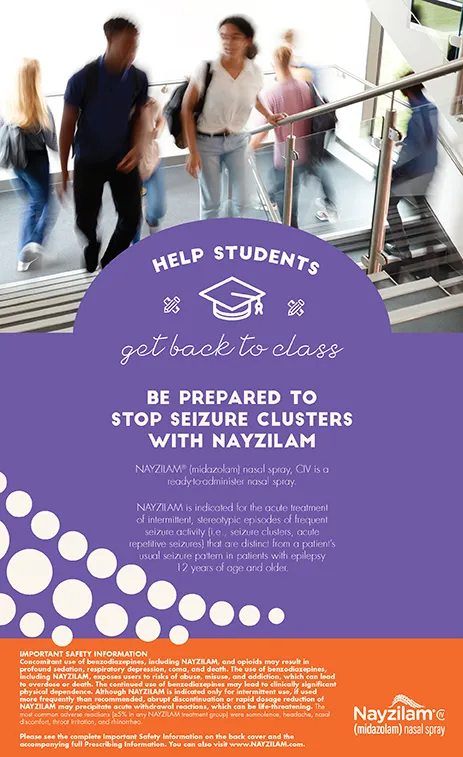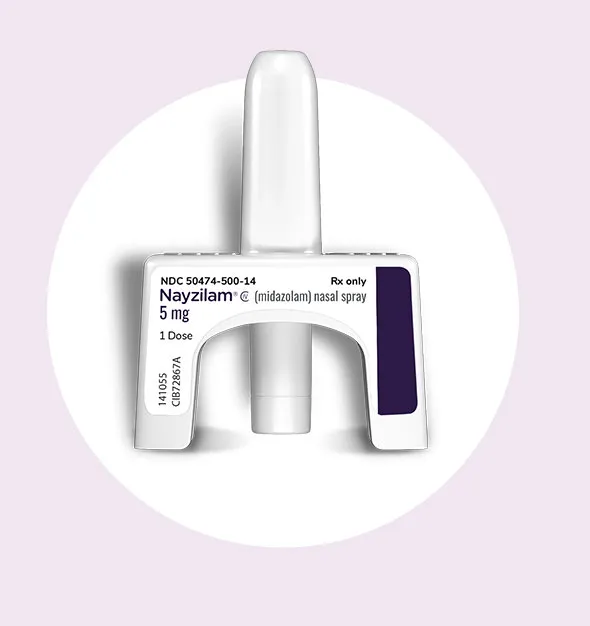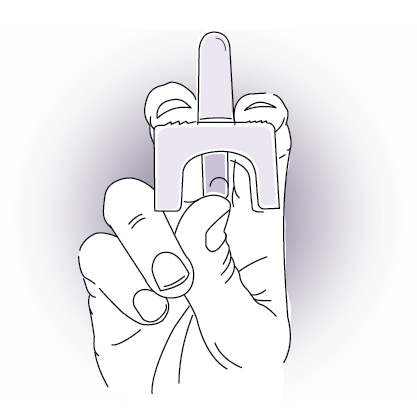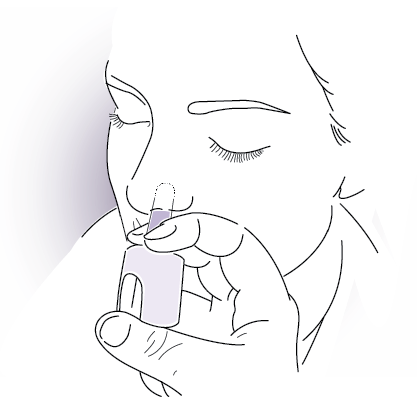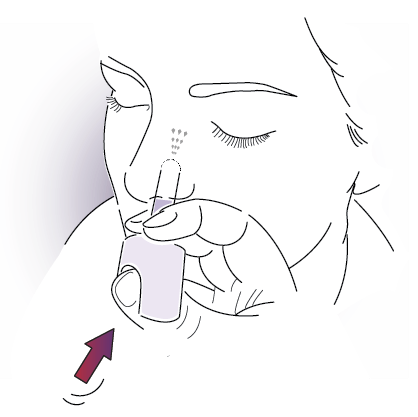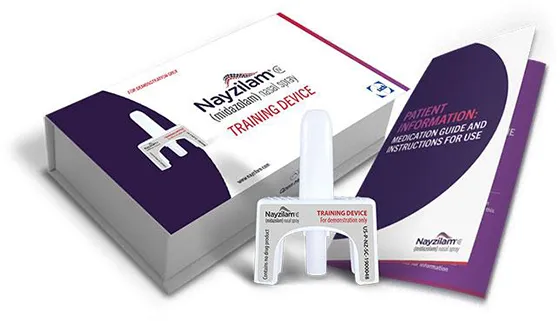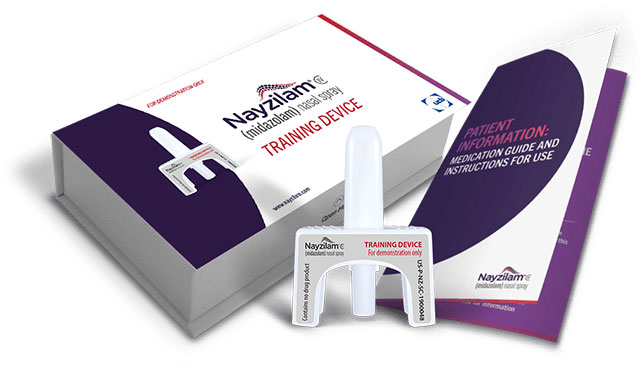IMPORTANT SAFETY INFORMATION
CONTRAINDICATIONS
NAYZILAM is contraindicated in patients with acute narrow-angle glaucoma.
RISKS FROM CONCOMITANT USE WITH OPIOIDS
Concomitant use of benzodiazepines, including NAYZILAM, and opioids may result in profound sedation, respiratory depression, coma, and death. Reserve concomitant prescribing of these drugs for patients for whom alternative treatment options are inadequate. Limit dosages and durations to the minimum required. Follow patients for signs and symptoms of respiratory depression and sedation.
ABUSE, MISUSE, AND ADDICTION
The use of benzodiazepines, including NAYZILAM, exposes users to risks of abuse, misuse, and addiction, which can lead to overdose or death. Abuse and misuse of benzodiazepines commonly involve concomitant use of other medications, alcohol, and/or illicit substances, which is associated with an increased frequency of serious adverse outcomes. Before prescribing NAYZILAM and throughout treatment, assess each patient’s risk for abuse, misuse, and addiction.
DEPENDENCE AND WITHDRAWAL REACTIONS AFTER USE OF NAYZILAM MORE FREQUENTLY THAN RECOMMENDED
The continued use of benzodiazepines may lead to clinically significant physical dependence. The risks of dependence and withdrawal increase with longer treatment duration and higher daily dose. Although NAYZILAM is indicated only for intermittent use, if used more frequently than recommended, abrupt discontinuation or rapid dosage reduction of NAYZILAM may precipitate acute withdrawal reactions, which can be life-threatening. For patients using NAYZILAM more frequently than recommended, to reduce the risk of withdrawal reactions, use a gradual taper to discontinue NAYZILAM.
RISKS OF CARDIORESPIRATORY ADVERSE REACTIONS
Serious cardiorespiratory adverse reactions have occurred after administration of midazolam. Warn patients and caregivers about the risks of respiratory depression, cardiac and respiratory arrest.
Respiratory depression was observed with the administration of NAYZILAM during clinical trials. Cardiac or respiratory arrest caused by NAYZILAM was not reported during clinical trials.
CENTRAL NERVOUS SYSTEM DEPRESSION FROM CONCOMITANT USE WITH OTHER CENTRAL NERVOUS SYSTEM DEPRESSANTS, OR MODERATE OR STRONG CYP3A4 INHIBITORS
Drug products containing midazolam, including NAYZILAM, have a central nervous system (CNS) depressant effect.
Risks from Concomitant Use with Other CNS Depressants
NAYZILAM may cause an increased CNS-depressant effect when used with alcohol or other CNS depressants (e.g., opioids). Warn patients and caregivers that the use of NAYZILAM in combination with alcohol or other CNS depressant drugs may increase the risk of hypoventilation, airway obstruction, desaturation, or apnea and may contribute to profound and/or prolonged drug effect.
Risks from Concomitant Use with Moderate or Strong CYP3A4 Inhibitors
Concomitant use of NAYZILAM with moderate or strong CYP3A4 enzyme inhibitors may result in prolonged sedation because of a decrease in plasma clearance of midazolam. Caution patients against engaging in hazardous occupations requiring mental alertness, such as operating machinery, driving a motor vehicle or riding a bicycle until they have completely returned to their level of baseline functioning.
SUICIDAL BEHAVIOR AND IDEATION
Antiepileptic drugs (AEDs), including NAYZILAM, increase the risk of suicidal thoughts or behavior in patients taking these drugs for any indication. Monitor patients treated with NAYZILAM for the emergence or worsening of depression, suicidal thoughts or behavior, and/or any unusual changes in mood or behavior. Advise patients and caregivers to be alert for these behavioral changes and to immediately report them to the healthcare provider.
IMPAIRED COGNITIVE FUNCTION
Midazolam, including NAYZILAM, is associated with a high incidence of partial or complete impairment of recall for several hours following an administered dose. Counsel patients on when they can engage in activities requiring complete mental alertness, operate hazardous machinery, or drive a motor vehicle after taking NAYZILAM.
GLAUCOMA
Benzodiazepines, including NAYZILAM, can increase intraocular pressure in patients with glaucoma. NAYZILAM may be used in patients with open-angle glaucoma only if they are receiving appropriate therapy. NAYZILAM is contraindicated in patients with narrow-angle glaucoma.
NEONATAL SEDATION AND WITHDRAWAL SYNDROME
Use of NAYZILAM late in pregnancy can result in sedation (respiratory depression, lethargy, hypotonia) and/or withdrawal symptoms (hyperreflexia, irritability, restlessness, tremors, inconsolable crying, and feeding difficulties) in the neonate. Monitor neonates exposed to NAYZILAM during pregnancy or labor for signs of sedation and monitor neonates exposed to NAYZILAM during pregnancy for signs of withdrawal; manage these neonates accordingly.
ADVERSE REACTIONS
In the randomized, double-blind, placebo-controlled trial, the most common adverse reactions (5% in any NAYZILAM treatment group) were somnolence, headache, nasal discomfort, throat irritation, and rhinorrhea.
NAYZILAM is a Schedule IV controlled substance.
Please see full Prescribing Information.
